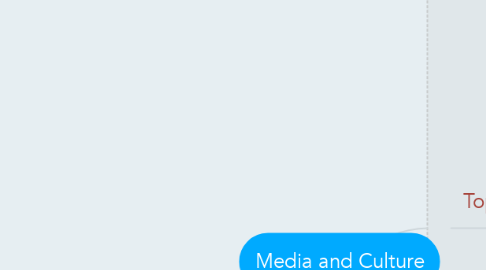
1. Topics
1.1. What is Culture?
1.1.1. Use of symbols
1.1.2. Sharing knowledge
1.1.3. Values, Beliefs, Attitudes
1.1.4. Social Culture
1.1.4.1. Norms
1.1.4.2. Customs
1.1.4.2.1. Rituals
1.1.4.2.2. Nonverbal cues
1.1.4.3. World View
1.1.4.3.1. Expectations
1.1.4.3.2. Interpretation
1.1.5. Material Culture
1.1.5.1. Clothes
1.1.5.2. Homes
1.1.5.3. Wealth
1.1.5.4. Food
1.2. Perception and Interpretation
1.2.1. World View
1.2.1.1. Shaped by media
1.2.1.1.1. Pop culture
1.2.1.1.2. Interests
1.2.1.1.3. Desires
1.2.2. Interpretation subjective
1.2.2.1. Attaching Values
1.2.2.2. Culture as template
1.2.2.2.1. Media as template
1.2.3. Values, beliefs, Attitudes color interpretation
1.2.3.1. What is beauty
1.2.3.2. What is good / bad
1.2.4. Media use of targeted audience
1.2.4.1. Message has purpose
1.2.4.1.1. Sell
1.2.4.1.2. Inform
1.2.5. Perception of situated culture
1.2.5.1. Rule based
1.2.5.2. Social codes
1.3. Rules and Norms
1.3.1. Fitting in
1.3.1.1. Common Sense
1.3.1.2. Guilt / Shame
1.3.1.3. Acceptance
1.3.2. Enculturation
1.3.2.1. Reward and Punishment
1.3.2.2. Education
1.3.2.3. Family Influence
1.3.2.4. Social Institutions
1.3.3. Part of Identity
1.3.3.1. Personal Limits
1.3.3.2. Choose Conformity
1.3.4. Use of Media as Trainer
1.3.4.1. Mass Media
1.3.4.2. School Textbooks
1.3.4.3. Internet Exposure
1.3.5. Impact on values, beliefs, attitudes
1.4. Situated Culture
1.4.1. Person to person
1.4.2. Rituals and ceremonies
1.4.3. Food as a Medium
1.4.4. Gift giving as Medium
1.4.5. Moving and Touching
1.5. Mediated Culture
1.5.1. Recorded Audio, Imagery and Text
1.5.2. Written Text
1.5.3. Mass Media
1.5.4. Interactivity
1.5.4.1. Games
1.5.4.2. Telephony
1.5.4.3. Online Chat
1.5.5. Cultural Dispersion
1.5.5.1. Imperialism
1.5.5.2. Marketing
1.6. Mass Media Characteristics
1.6.1. Messages are Products
1.6.2. Shaping Society
1.6.3. Manipulate Society and Individual
1.6.4. Helps define our World View
1.6.5. Specific vs Generalized Targets
1.7. Advertising Techniques
1.7.1. Target Specific
1.7.2. Thematic use of Colors, symbols, fonts, faces, backgrounds, etc.
1.7.3. Market Research important
1.7.4. Catch Phrases, key cultural words
1.7.5. Helps Define our Identity
1.8. Role Models in Media
1.8.1. Target recognizes role model
1.8.2. Hero adulation
1.8.3. Desires for Status, Conformity, Acceptance
1.8.4. Symbol of Values in culture.
1.8.5. Familiarity equals Respect
1.9. Social Media in Social Movements
1.9.1. Arab Spring
1.9.2. Twitter, Facebook, Google
1.9.2.1. To Attack or Praise
1.9.3. Online Forums, Chat
1.9.4. Political Elections
1.9.5. Membership Systems
1.10. Modern Mobility
1.10.1. Insecurity
1.10.1.1. ID Theft
1.10.2. Sharing personal information
1.10.3. Instant Knowledge of surroundings
1.10.4. Applications in work
1.10.5. Cloud Computing
1.11. Self Identity
1.11.1. Inherent Variables
1.11.1.1. Gender
1.11.1.2. Age
1.11.1.3. Race
1.11.1.4. Class
1.11.1.5. Ethnic group
1.11.2. External Variables
1.11.2.1. Beliefs
1.11.2.2. Values
1.11.2.3. Attitudes
1.11.3. Unsupported or Restricted by Mainstream
1.11.4. Role of Family
1.11.5. Personal Worth
1.12. Sub-cultures
1.12.1. Minorities
1.12.2. Youth cultures
1.12.3. Rejection of Mainstream
1.12.4. Unique Communication styles
1.12.5. Unique genre of expression (music, art, dance)
